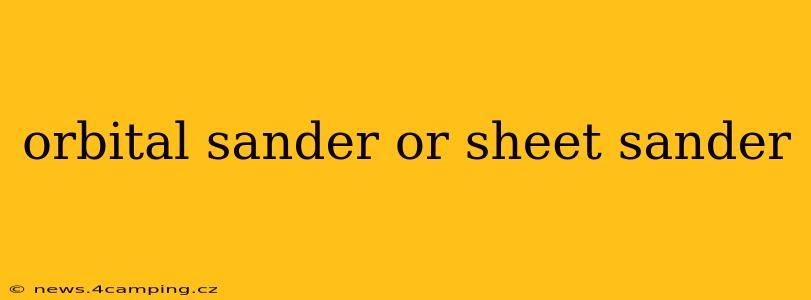Choosing between an orbital sander and a sheet sander can feel overwhelming, especially for DIY enthusiasts or those tackling a project for the first time. Both tools excel at sanding, but their designs and applications differ significantly. This comprehensive guide will delve into the strengths and weaknesses of each, helping you make an informed decision based on your specific needs.
What is an Orbital Sander?
An orbital sander is a power tool that uses a circular sanding pad that oscillates in a small, rapid orbital motion. This random orbital pattern minimizes swirl marks, resulting in a smoother, more even finish. They are versatile and suitable for a wide range of projects, from furniture refinishing to automotive detailing. Different grits of sandpaper can be easily attached and changed.
What is a Sheet Sander?
A sheet sander, also known as a finishing sander, typically utilizes a rectangular sanding pad and moves in a back-and-forth motion. This makes them particularly effective at smoothing large, flat surfaces quickly. However, because of their linear motion, they are more prone to leaving swirl marks if not used carefully. They usually require clamping down a sheet of sandpaper, making the process slightly more involved.
What are the Advantages of an Orbital Sander?
- Smoother Finish: The random orbital action minimizes swirl marks, leading to a superior finish.
- Versatility: Suitable for various surfaces and projects, from curves to flat areas.
- Ease of Use: Generally easier to control and maneuver, especially for beginners.
- Wide Range of Sandpaper: Readily accepts different grits of sandpaper for various stages of sanding.
What are the Advantages of a Sheet Sander?
- Speed and Efficiency: Covers large areas much faster than an orbital sander, ideal for extensive projects.
- Aggressive Sanding: Can remove material more quickly due to its linear motion, useful for initial sanding steps.
- Cost-Effective: Often less expensive than comparable orbital sanders.
Which Sander is Best for Beginners?
For beginners, the orbital sander is generally recommended. Its ease of use and forgiving nature make it less prone to mistakes. The random orbital action helps prevent significant errors, even if technique isn't perfect.
Which Sander is Better for Large Projects?
For large projects requiring sanding of extensive flat areas, the sheet sander often proves more efficient. Its speed and ability to cover a lot of ground quickly makes it the better choice in these scenarios. Think sanding floors, large tabletops, or walls.
Which Sander is Better for Detail Work?
The orbital sander, with its smaller sanding pad and maneuverability, is far superior for detail work and sanding in tight corners or around intricate shapes. A sheet sander is simply too large and unwieldy for these tasks.
Can I Use Both an Orbital and a Sheet Sander?
Absolutely! Many professionals and serious DIYers use both types of sanders. The sheet sander might tackle the bulk of the sanding on a large flat surface, while the orbital sander would then refine the finish and handle detail work. This combination offers the best of both worlds.
What is the Difference in Price Between an Orbital and Sheet Sander?
Prices vary greatly depending on brand, features, and power. Generally, you can find entry-level models of both for similar prices, but higher-end models of orbital sanders can be significantly more expensive than their sheet sander counterparts.
Conclusion: Choosing the Right Sander
The best sander for you depends entirely on your needs and project requirements. Consider the size of the project, the type of surface, the desired finish, and your experience level. If you're unsure, starting with an orbital sander is a safe bet, as its versatility makes it suitable for a wider range of applications. However, for large-scale projects involving flat surfaces, a sheet sander might be a valuable addition to your tool collection. Remember to always prioritize safety and use appropriate personal protective equipment (PPE) when operating any power tool.
